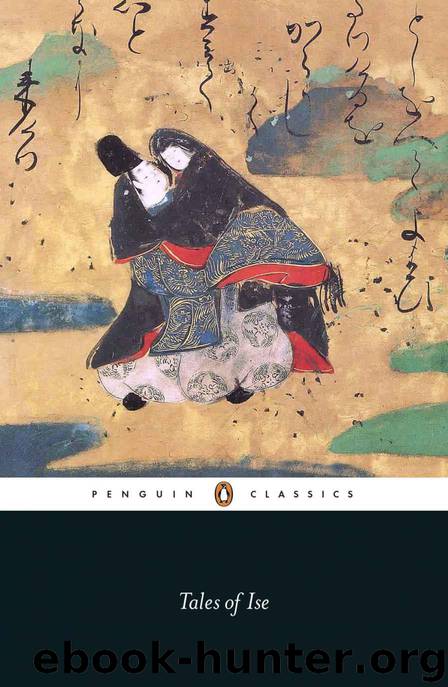The Tales of Ise (Penguin Classics) by Donald Keene & Peter MacMillan

Author:Donald Keene & Peter MacMillan [Keene, Donald & MacMillan, Peter]
Language: eng
Format: epub
ISBN: 9780141392585
Publisher: Penguin Books Ltd
Published: 2016-08-31T22:00:00+00:00
24
The Bow of the Crescent Moon
Despite the somewhat far-fetched ending, Episode 24 is one of the most poignant of the Tales. Like Episode 23 (see the commentary above), it contains a poem that makes particularly fine use of alliteration.
Like Episode 23, to which this story forms a good contrast, Episode 24 takes place in the countryside. A husband and wife live in a remote place, but the husband, wishing to find a position as a court official, leaves for the capital without returning for three years. Unable to wait any longer, the wife promises herself in marriage to another man on the very day that the original husband returns. The ‘new pillow’ (niimakura) the lady mentions in the first poem refers to a man and woman spending the first night of their marriage together.
The second poem, a reply to the first, is based on a traditional folk song. The first two lines (Azusa-yumi / ma-yumi tsuki-yumi), full of beautiful alliteration in the Japanese, refer to three types of bow, made of different kinds of wood, though the underlying meaning is unclear. One theory is that since men of the time always carried a bow with them and handled it with great care, it represents something of importance to the man. This is the view of Yamamoto, who argues that the poem should be read as a plea from the first husband to the new one: ‘Just as a man handles a bow carefully, I have cherished my wife. Take care of her as I have done.’ The more standard interpretation, adopted in this translation, is that the man is comparing the long-stretched bow of the moon (tsuki) to his love, and the poem is addressed to his wife.
The third poem also uses the bow as a metaphor to speak of the lady’s love for her former husband. When the bow is drawn, the frame bends and the ends come closer. This conceit of a bent bow was often used in the poetry of the time. Here, the lady asserts that, as in the past, her heart is drawn to his at all times. The translation is a slight adaptation of this conceit. Many poems in the Man’yōshū use a similar expression, and this poem is thought to have been based on them. The husband ignores the lady’s poems and leaves. She runs after him but is unable to catch him and collapses beside a spring. She writes the fourth poem on a nearby rock with the blood draining from her finger and then dies in despair. The melodramatic ending, ususual in this work, is surely another form of literary experimentation (see here), and may even have been read as somewhat comical.
Download
This site does not store any files on its server. We only index and link to content provided by other sites. Please contact the content providers to delete copyright contents if any and email us, we'll remove relevant links or contents immediately.
The Universe of Us by Lang Leav(14834)
The Sun and Her Flowers by Rupi Kaur(14333)
Adultolescence by Gabbie Hanna(8595)
Whiskey Words & a Shovel II by r.h. Sin(7811)
Love Her Wild by Atticus(7594)
Smoke & Mirrors by Michael Faudet(5940)
Wiseguy by Nicholas Pileggi(5324)
The Princess Saves Herself in This One by Amanda Lovelace(4822)
Love & Misadventure by Lang Leav(4696)
Milk and Honey by Rupi Kaur(4594)
Memories by Lang Leav(4574)
Bluets by Maggie Nelson(4268)
Good morning to Goodnight by Eleni Kaur(4105)
Too Much and Not the Mood by Durga Chew-Bose(4097)
Pillow Thoughts by Courtney Peppernell(4022)
Algedonic by r.h. Sin(3884)
The Poetry of Pablo Neruda by Pablo Neruda(3821)
HER II by Pierre Alex Jeanty(3477)
Stuff I've Been Feeling Lately by Alicia Cook(3315)
